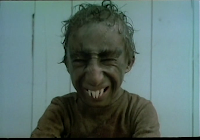Le test image :
"The sad fact of the matter is that, while he was once a great filmmaker, William Friedkin lost his marbles sometime during the 1980s and never recovered. As further evidence of that, this Blu-ray edition presents us with a newly recolored version of 'The French Connection' that bears no resemblance whatsoever to the movie's original photography. William Friedkin personally supervised the transfer, and defends his decisions in the disc supplements.
The new color timing is so radically invasive that it sparked a war of words between Friedkin and the film's cinematographer Owen Roizman, who said of the Blu-ray, "I wasn't consulted. I was appalled by it. I don't know what Billy was thinking. It's not the film that I shot, and I certainly want to wash my hands of having had anything to do with this transfer, which I feel is atrocious." To which Friedkin then lashed out at Roizman in a lengthy interview where he barely stops short of calling the man incompetent. I recommend listening to that interview in its entirety. Despite his years of experience, Friedkin demonstrates a shocking ignorance of photography, film, video, and Blu-ray in particular. He seems to believe that all movies on Blu-ray are recolored the way this one was as a matter of course. He is gravely mistaken.
I'm not going to mince words about this. I side with Roizman. The new color scheme looks unnatural and doesn't suit the material at all. I'd like to support the right of a director to control the way his movie looks, but this is just ridiculous. Filmmakers are artists, but sometimes artists lose their perspective over the years and try to impose revisionist ideas that are not in the best interest of the original work (see also: Lucas, George). Even though Friedkin may not have removed or added any footage to the movie, his color changes are so severe that what we have on this Blu-ray shouldn't be called 'The French Connection' at all. It's a different movie now. This is 'The French Connection Redux'.
So what did he do, exactly? The recoloring process is explained in some depth in the disc's supplements. Essentially, after the original film negative was scanned for the video transfer, Friedkin felt that the colors were too intense and detracted from the "documentary-like" style he wanted. That sounds like a sensible enough complaint. You'd think that the logical solution would be to simply dial down the colors. Instead, Friedkin had the entire color palette digitally stripped from the movie, leaving him with black & white image. He then took the color layer, oversaturated it, defocused it, and bled it back in on top of the black & white layer. The director describes the new colors as "pastel." How giving the movie pastel colors is supposed to make it look more like a documentary, I cannot fathom. There's a profound disconnect between what Friedkin says that he wants and what he's actually doing.
The problems with this process are evident right in the movie's opening shot, a skyline view of Marseilles. There's a building on frame left. As a result of the recoloring, the side of the building is now the exact same shade as the sky, which makes the shot look like a bad matte painting with a huge gap down the middle. The other sides of the building are a different color entirely. You'd think the director might notice that.
The effect of all this is that 'The French Connection' now looks like one of those old black & white movies that Ted Turner colorized in the '80s. It's a cartoonish facsimile of the movie. The colors are filled with chroma noise and frequently bleed. Flesh tones often have a sickly purple hue for no good reason. Friedkin also jacked up the contrast while he was at it. Whites bloom and shadow detail is crushed. And because the color layer was defocused, that means that part of the image is literally out of focus. In the color timing featurette, Friedkin proudly demonstrates before-and-after comparisons of the original negative against his "corrected" version, and you can watch half the detail in the picture vanish as soon as he flips the switch. The combination of boosted contrast and defocusing also gives many parts of the image, especially facial features, a strange glow.
In other respects, the 1080p/AVC MPEG-4 transfer (presented in its 1.85:1 theatrical aspect ratio) has detail that varies shot-to-shot from fair to downright awful. 'The French Connection' was always rough around the edges. In its original conception, the movie was meant to look drab and grainy. However, Friedkin currently claims that he now hates film grain, and boasts that his new process will clean it all up. That stands in stark contrast to how the disc actually looks. The picture is still grainy as hell, and all the digital manipulation gives the grain a nasty electronic texture that isn't film-like at all.
At its best, there are parts of the movie that don't look too distorted. After a while, it becomes possible to tune out the manipulations and try to enjoy the movie despite them. Unfortunately, time and again the colors are just so downright bizarre and distracting that it's impossible to concentrate on the story. Shame on William Friedkin for doing this to his movie. What was he thinking? "
La critique complète :
http://bluray.highdefdigest.com/1916/fr ... ction.html





